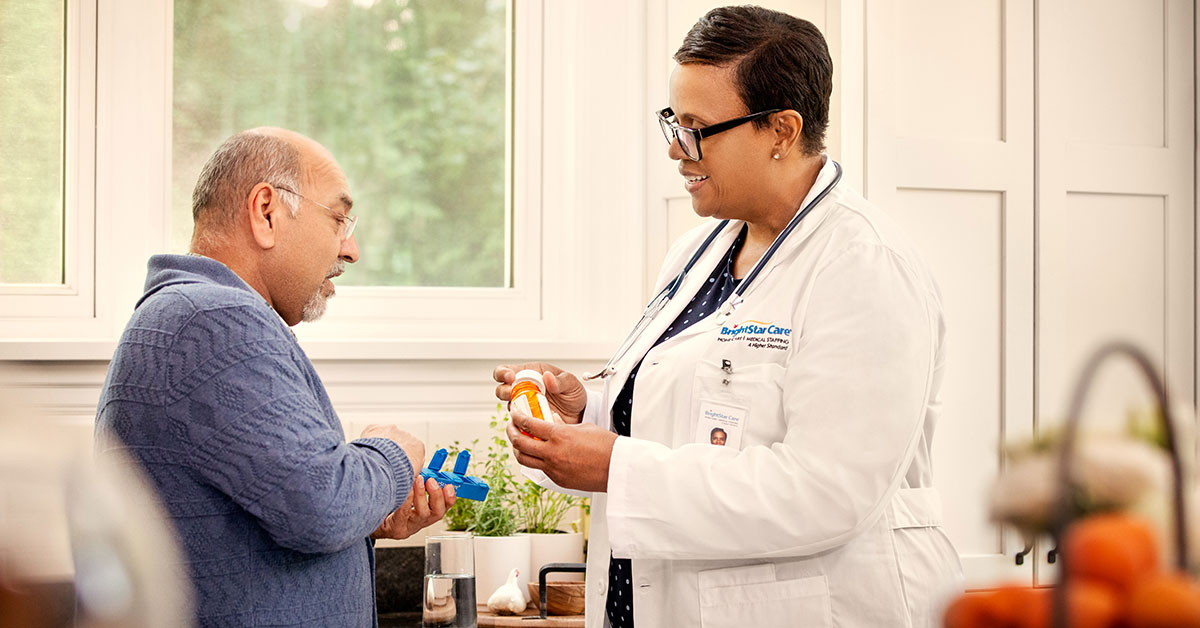 Learning that a loved one needs to go home from a hospital or rehabilitation facility can prompt a range of emotions: happiness, relief, nervousness, maybe even fear. They likely will need short-term home care for a few weeks or even longer, depending on their health and mobility.
Learning that a loved one needs to go home from a hospital or rehabilitation facility can prompt a range of emotions: happiness, relief, nervousness, maybe even fear. They likely will need short-term home care for a few weeks or even longer, depending on their health and mobility.
A BrightStar Care team member at one our agencies recently shared a story about a less-than-smooth transition that prompted a family to reach out to us for help. Their loved one was being discharged from a nursing and rehab facility the next day and would require specialized care at home from multiple providers. However, the family had not been given the transfer and discharge summary, which includes the client’s care instructions, health history, and medications. Additionally, essential medical supplies were not delivered in time for their scheduled use causing the family an unnecessary emergency room visit to provide critical health services for their loved one.
Clearly, there had been a major breakdown in communication to the BrightStar Care agency during the transfer that could have put the patient’s life at risk had the family not reached out for help. While this was an extreme case, similar middle-of-the-road incidents are common. Let’s go over a few things caregivers can do to prepare for a loved one’s return home and prevent frustration, stress, and needless suffering.
Learn more about the transitional care services that BrightStar Care provides.
Ask questions and learn your options
We often receive calls from families whose loved ones are being discharged from a facility that day. While it’s not always possible to say for certain when someone will be discharged, it’s best to start planning as soon as possible to avoid a scramble at the end. I know it can seem overwhelming, but a little education and awareness can go a long way.
Ideally, a discharge planner, case manager, or social worker will walk you through the process, explain your choices and decisions, and help coordinate home care if necessary. Unfortunately, working with a discharge planner isn’t always an option. Your family may need to put in a little extra work to learn your options and get answers to questions.
You’ll first want to make sure you understand the level of care your loved one will need when they arrive home. This could include:
-
Companion care
-
Medication management
-
Personal care services, such as help bathing, grooming or eating
-
Skilled nursing services such as IV medications, feeding tubes or treatment of wounds
-
Physical or occupational therapy or an exercise program
-
Hospice
-
Palliative care
Check with your loved one’s insurance company to find out which services they will cover and which companies they accept. For example, Medicare rarely if ever covers companion care or most other personal care services. If your loved one is a military veteran, they may qualify for coverage of certain services through the VA program known as Veteran’s Aid and Attendance. Government-funded programs also may provide select services to income-eligible individuals. If some services need to be paid for out-of-pocket, have a family discussion about how to cover the costs.
Some hospitals have their own home care agencies that will automatically set up services. While this can be convenient, it might be worth evaluating your options to make sure your loved one is getting the best care. When setting up skilled services or choosing a home care agency, make sure you understand exactly what services your loved one will be getting. You may discover that you might need more than one home care provider to meet all of your needs. This may be especially true if you are eligible for Medicare home health as there are limitations on who and what is covered, often much less than most people expect. Learn more about Medicare-covered home health services at www.medicare.gov.
Before your loved one leaves the hospital or rehab facility, make sure you have all necessary documents in hand, including a discharge summary and medication list. The next step is to prepare your loved one’s home for a safe arrival and recovery.
How to improve safety in the home
You don’t need to turn your loved one’s home into a hospital, but a few simple changes can make their home safer.
Your local BrightStar Care team can help you identify specific risks and make recommendations to improve safety. Here are a few common safety updates to consider:
-
Bathroom: Install a shower chair and grab bars in the bathtub or shower.
-
Furniture: If your loved one needs a walker or wheelchair, make sure there’s enough space between furniture to maneuver safely. Check to see if the door to the bathroom is wide enough as well.
-
Throw rugs: These are the No. 1 trip hazard for seniors. Get rid of them wherever possible.
-
Night lights: These can help your loved one maneuver safely at night.
Related reading: Home safety tips for each room in your house
Medication management is another piece of the puzzle when it comes to making a safe transition home. You’ll need to make a plan if your loved one needs help taking their prescriptions appropriately. It is important to explore what Medicare will and will not do when it comes to medication administration.
Bringing a loved one home from the hospital can seem overwhelming, but you’re not alone. Our teams at BrightStar Care are dedicated to helping you put things in place for a safe, low-stress transition. Call 866-618-7827 or contact a BrightStar Care® home care agency near you to learn how your loved one might benefit from in-home care services.

